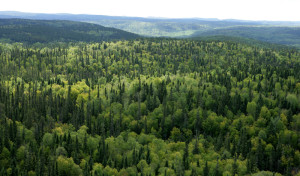
250 years of ineffective forest management doesn’t mean that we can’t get it right in the future
A study published in last week’s issue of Science, a prestigious scientific journal,seemed to uncover another negative consequence of the human footprint: 250 years of forest management in Europe didn’t remove carbon from the planet, but added to it.
The three European authors of this study simulated carbon emissions from changes in land-cover and results of forest management across Europe between 1750 and 2015. They found that in the first hundred years, 190 000km2 of forests were removed. In the years that followed, 386 000km2 of forests were added, leading to a net increase in forest cover. Going against conventional wisdom though, the authors suggested that the trees that were initially removed released more carbon than what the new trees had absorbed, resulting in a total of 3.1 billion tonnes of carbon dioxide remaining in the atmosphere, equivalent to the emissions from 6.5 million cars in America annually.
Rather than adding to the argument for the sustainable use of our forests, this study puts the world’s forests at risk by suggesting that humans cannot handle it. The reality is forest management has not failed; forests must be, and have recently been, sustainably managed by humans. Human intervention is especially needed if we are to balance the needs of an increasing population size, the need to mitigate climate change, and the need to deal with biodiversity issues.
The study uses the forest management techniques of the industrial revolution as evidence that humans do not belong in forests. This is not appropriate. Before the mid-20th century, which takes up an entire three quarters of the study period, forests were only seen for their timber – meaning that there was no true form of management as we understand it today. Any of the trees planted were species that made a profit, which lead to the straight-lined monocultures lacking the lush greenery that we associate with forests today.
The first introduction of the use of forests beyond timber in Europe was 1957 by the Germans; and the first time clear-cutting was argued against in Ontario was in 1947. There were no policies that protected any environmental aspect of forests then. In fact, even during the mid-20th century, forests were still managed only for sustained yield, which aimed to leave trees for timber for future generations.
Presently, unlike the past 250 years the authors focus on, there is a thriving global industry on certifying forests as sustainable.
It was only twenty-five years ago that the international community recognized that forests needed policies for protection and sustainable use; the concept of sustainable forest management was accepted in the early 1990s, meaning that sustainability has been a guiding light only since then. Remember too that climate change was only recognized as a global problem in 1987.
In a majority of the studied time period, there was no consideration for biodiversity, forest regeneration, and certainly no consideration for carbon sequestration. There was no forest management in Europe.
By suggesting that the history of “forest management” has contributed to climate change then, the authors have misled readers into thinking that good forest management is not possible. It is, and Canada is a great example. Forest certification systems (SFI and FSC) and government policies (such as Ontario’s Crown Forest Sustainability Act, 1992) have led to forests being managed throughout Canada for their social, environmental and economic values. Today, Ontario leads the world in certified forests, a result of the sustainable forest management policies enacted in the 1990s.
Earlier this year, five forest companies, the provincial government, twenty-six aboriginal groups and three environmental organizations signed a globally unprecedented deal for forest conservation–85% of the Great Bear Rainforest would be protected forever, part of the only temperate rainforest on this continent. Greenpeace, a loud critic of forestry companies, proudly proclaimed that this deal was one of the most comprehensive conservation and forest management plans in the world.
Further, by insinuating that humans still cannot get it right even when we plant trees, the authors failed to emphasize that the trees that were planted were not meant to sequester carbon. They were meant to be cut down. This argument reinforces the dangerous notion that humans and nature are mutually exclusive; as a society, we must see ourselves as stewards of this earth.
We have now reached a point in forest governance where the real issues of deforestation have been recognized and the potential for forests in mitigating climate change has been acknowledged. Rather than suggesting any human touch is dangerous, we must see ourselves as positive members of this earth. There is evidence that when humans implement sustainable forest management in its strongest form, we are able to not only sequester carbon and enhance biodiversity, but also use of one of the strongest building materials available–wood.
“Forests are the lungs of our world,” President Franklin D. Roosevelt once said. The world’s lungs must be exercised so that they become stronger and more efficient; as part of our forest management then, we must learn how to balance social, environmental and economic concerns. Most importantly, we must learn from our mistakes.
The authors ended their study suggesting that, “the key question now is whether it is possible to design a forest management strategy that cools the climate and, at the same time, sustains wood production and other ecosystem services.” I argue that it is definitely possible. Just look at us Canadians.
